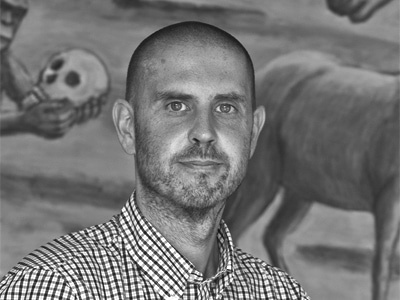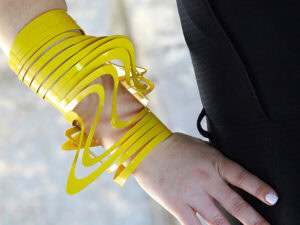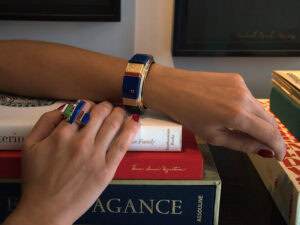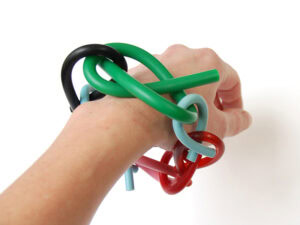By Way of Introduction
In 2008, I received a grant from Creative New Zealand, the government arts funding agency, to travel to Europe and give some lectures about New Zealand contemporary jewelry. I’m a trained art historian who started writing about jewelry a couple of years ago and quite quickly I became aware of my ignorance regarding the international jewelry scene – and how important it was for me to make connections with jewelers and writers living overseas. The grant let me travel to America, England, the Netherlands, Germany and France. Here’s a somewhat fanciful record of some of the things that happened to me along the way.
Making Connections in San Francisco
New Zealand jewelry has very few historic links to American jewelry. We have looked to Australia, our closest neighbour and then to Europe. We know a bit about European jewelry, thanks to the pioneering connections of Warwick Freeman (who has, since the late 1980s, exhibited in the Netherlands and Germany) and to Lisa Walker (who moved to Munich, studied with Otto Künzli and married Karl Fritsch). But we know very little about America. If you asked me about contemporary American jewelry, I would tell you it is narrative and figurative and quite different from European jewelry.
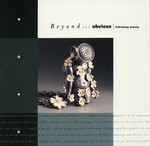
I’m sure an American reader would be shocked that I could possibly imagine their jewelry to be anything other than excellent. But in New Zealand we assume that any battle between American and European jewelry would see a victory for the European makers because it is so much better. After actually seeing some work (in this catalog, at Velvet Da Vinci gallery and in Susan Cummins’s collection) I’m not so sure. I start to get excited because I’m coming close to hitting the edges of my preconceptions, my own blindness. Assuming American jewelry is good means I need to get rid of the expectations and beliefs that stop me from seeing it properly. I’m going to be able to identify the values that I’ve inherited without thinking, take a good look at them and either keep them or throw them out.
All the Schmuck in the World
The Schmuckmuseum in Pforzheim must be a highlight of any jewelry lover’s museum experiences. To be honest, it gives me a case of culture shock. I’m torn between feeling sorry for European contemporary jewelers, who have to deal with the weight and excellence of the past; and feeling envious, because they get to experience the rich diversity and history of jewelry, to know they are part of a tradition that stretches back into antiquity. I suppose this is what makes European contemporary jewelry so good: not everything is possible here, there are rules and traditions that demand to be respected and if you are going to make a contribution then your work will have to contribute something impressive to a centuries-long dialogue.
I feel a bit conflicted. On the one hand, how lucky we are to live in New Zealand where the jewelry past sits so lightly on our shoulders; and on the other, how much easier it is for us to get away with work that isn’t anywhere near as good or as historically literate as it should be.
Coming from New Zealand, it is very noticeable to me that ethnic adornment is missing from the historical galleries. A little bit of Asian and Indian jewelry makes it into the historical gallery and some European folk jewelry is also included. But it is made clear that adornment from the Pacific, or Africa, say, is quite different from the gems that fill this part of the museum.
My unease grows when I see the Eva and Peter Herion collection of ethnographic jewelry. The wall text says that ‘Eva and Peter Herion visit the refuges of traditional societies to acquire outstanding testimony to past forms of life and exquisitely crafted art before these societies have fallen victim to the inexorable advance of modernisation.’ There are some fantastic examples of adornment here, and the gallery works on a rotating display that covers every culture, eventually. (When I visited, India, Africa, Papua New Guinea, Namibia and Northern Thailand were on display.)
But there are some real problems, such as the lack of dates for any of the objects, in marked contrast to the careful chronology given to the European historical jewelry. These objects are static, mythic, trapped outside history, their timelessness critical to their authenticity as evidence of dying cultures. These objects desperately need to be allowed back into time, as the work of cultures that are changing and adapting – rather than being eradicated – by the modern world. This is a very old-fashioned way to present other cultures and a surprise in a museum that is otherwise so innovative.
Dealing with Dutch Identity
Before heading overseas I made contact with two jewelers living in Amsterdam whose work particularly interested me. Terhi Tolvanen was originally from Norway, and her work appealed because of its particular take on nature. She uses natural materials like wood, shell, and stones and conducts these subtle and intelligent interventions which both respect the found quality of the material and undermine it. Peter Hoogeboom is a Dutch jeweller whose work has a kind of ethnographic feeling. He makes these wonderful necklaces that feel ‘primitive,’ but you can’t pin down what culture they are from.
For me, thinking about these jewelers is really thinking about identity. Issues of ethnicity and place have been big for us back home and New Zealand jewelry is full of references to Maori (the indigenous people) and Pacific Island cultures, as well as nature and unique natural materials. It is part of how we have established a place for ourselves in the world. The same is not true for Dutch jewelry, which, being in the centre of international jewelry, doesn’t use place or identity to define itself. Dutch jewelry isn’t good because it is Dutch – it’s good because it is the best jewelry being made, period. (At least, that’s what the Dutch will tell you!) A few people I met asked what did it matter where they came from? What exactly was the Dutchness of Dutch jewelry? Clogs and cheese? Windmills?
Terhi Tolvanen told me a wonderful story about nature, which helped me think about these issues. While she was studying at the Rietveld Academy in Amsterdam, she went on a class trip to a forest. Seeing a mushroom, she went to kick it. Her classmates said, ‘Why are you kicking the mushroom? Someone else might like to look at it.’ I laughed when she told me this, since in New Zealand, just like in Norway, there are endless numbers of mushrooms and of course you kick them. But in the Netherlands, nature isn’t as natural or bountiful as it is in other parts of the world. It is a threat, something to be controlled and dominated or ordered and treasured.

All of which made me realise that when I talk about the effects of identity, I don’t mean obvious national identity – the cheesy signs of being Dutch, or American, or a New Zealander that you can buy in souvenir shops. Rather, I’m referring to habits of mind. It must affect you when you live in a country that is effectively under water, in which the ocean is a dangerous force to be overcome. It must affect you when you live in a historically powerful colonial country, the center of the world for three centuries. I know these issues are not the only way to think about contemporary jewelry, but should they be acknowledged? What do you gain, or lose, when you bring them into the conversation?
Bonjour Bijou
Almost everyone I encountered in Germany, the Netherlands and England agreed that France is a kind of black hole, an absence and void in the map of European jewelry. I was often questioned as to why, in a trip to see and meet European jewelers and their work, I would go to Paris. The general belief was that nothing much had happened in France since Lalique did some quite cool things with bijoux (jewelry) in the early twentieth century.
Arriving in Paris, I discovered a contemporary jewelry scene, met a number of jewelers, attended an exhibition opening and even got a copy of Also Known as Jewellery*, a catalog for an exhibition of French jewelry curated by Christian Alandete and Benjamin Lignel that is currently touring to galleries in England, America, Italy and Germany. That show was organised by La Garantie, an association for French contemporary jewelry, so they even have an institution dedicated to promoting their work. Not too shabby for a practice that isn’t supposed to exist.
Most surprising for me were the similarities between France and New Zealand. There are few internationally known French jewelers (Monika Brugger and Frederic Braham being the most famous) just as we really only have two jewelers (Warwick Freeman and Lisa Walker) with significant reputations overseas. Just like us, the French are starting to utilise networks and connections, working hard to insert themselves into European jewelry. Just like New Zealand, but unlucky when you consider how many more people live in France (61 million versus four million) they only have a few jewelry schools. And, same in both countries, the length of time spent studying jewelry is too short, a few years only. Unlike New Zealand, France has very few galleries (public or private) committed to showing and supporting contemporary jewelry.
The case of French jewelry shows what can be done by a few enthusiastic, talented and committed people; and it is a good reminder that there are always people worse off than New Zealand jewelers. It’s also a depressing reminder of how hard it can be to get invited to the party of contemporary jewelry, how little the scene cares for anything off the radar or out of site.
Transit Trauma
On the train from Pforzheim to Amsterdam, I decide that I am never going to write about New Zealand jewelry again. Apart from a few exceptional individuals, it just isn’t good enough to take its place in a world jewelry story. I’m only going to write about European and American jewelers, the very best in the world. I start to plan which international city I’ll live in.
A few days later, on the train from Amsterdam to Paris, I decide I am never going to write about anything other than New Zealand jewelry. Forget Europe, I LOVE New Zealand and everything about it. If the rest of the world is too stupid to see the brilliance of contemporary jewelry from that beautiful island I call home, then they can all get lost. I vow never to go overseas again.
Sitting on the train to the Munich airport, about to fly back to New Zealand, I realise that I’ve just experienced the point of travelling overseas. You lose your innocence and certainty. New Zealand contemporary jewelry is neither the worst nor the best in the world. My travels have confirmed that New Zealand is a small country which will only ever play a small role in world jewelry. But it has also shown me that there’s a lot to be gained from the viewpoint you get at the bottom of the world. When you know you’re not the centre of things, you end up less inward-looking than those people who live in culturally powerful countries and have no need to worry about what might be happening anywhere else.
New Zealand jewelry can foot it with the rest of the world and it has a place in the discussion just as much as jewelry from any other country. It’s not bad to be reminded that hard work and excellence are requisites for success. I start to wonder what my next trip overseas will teach me and realise I can’t wait to get home.
* * *
A modo de introducción
En el año 2008, recibí una beca de Creative New Zealand, la agencia gubernamental de financiamiento de las artes para viajar a Europa y dar algunas conferencias sobre la Joyería Contemporánea en Nueva Zelanda. Soy historiador de arte calificado que comenzó a escribir sobre la joyería hace un par de años y muy rápidamente me di cuenta de mi ignorancia con respecto a la escena internacional de la joyería – y lo importante que era para mí hacer conexiones con joyeros y escritores que viven en el extranjero. La beca me permitió viajar a América, Inglaterra, los Países Bajos, Alemania y Francia. Aquí hay un registro un tanto fantasioso de algunas de las cosas que me sucedieron en el camino.
Haciendo Conexiones en San Francisco
La joyería de Nueva Zelandia tiene algunas conexiones históricas con la joyería americana. Hemos visto hacia a Australia, nuestro vecino más cercano y luego a Europa. Sabemos un poco de la joyería europea, gracias a las conexiones pioneras de Warwick Freeman (que desde finales de los años 80 ha expuesto en Holanda y Alemania) y a Lisa Walker (que se mudó a Munich, estudió con Otto Künzli y se casó con Karl Fritsch). Pero sabemos muy poco acerca de América. Si me preguntas sobre la joyería americana contemporánea, te diría que es narrativa y figurativa y muy diferente de la joyería europea.
En San Francisco me entregaron el catálogo Más allá de lo obvio: Repensar la joyería (Beyond the Obvious: Rethinking Jewelry), que cuenta con el trabajo de Jamie Bennett, Lisa Gralnick, Keith Lewis, Bruce Metcalf, Sondra Sherman y Kiff Slemmons. Ojearlo demuestra sin lugar a dudas que la joyería americana es de buena calidad -seria, comprometida, con un lenguaje desarrollado. No siempre entiendo este lenguaje pero la exposición a nuevas cosas es por lo que estoy viajando.
Estoy seguro de que un lector estadounidense se sorprendería de que yo pueda imaginar que su joyería sea otra cosa que excelente. Pero en Nueva Zelandia asumimos que cualquier batalla entre la joyería americana y la europea aseguraría una victoria para los creadores europeos porque es mucho mejor. Después de realmente ver algunos trabajos (en este catálogo, en la galería de Velvet Da Vinci y en la colección de Susan Cummins) no estoy tan seguro. Empiezo a emocionarme porque estoy cerca de llegar a los límites de mis ideas preconcebidas, de mi propia ceguera. Suponer que la joyería americana es buena significa que necesito deshacerme de las expectativas y las creencias que me impedían ver correctamente. Voy a ser capaz de identificar los valores que he heredado sin pensar, echarles un buen vistazo y mantenerlos o desecharlos.
Todos los Schmuck en el mundo
El Schmuckmuseum en Pforzheim debe ser un punto culminante de las experiencias museísticas de cualquier amante de la joyería. Para ser honesto, me ocasiona un choque cultural. Me divido entre sentir pena por los joyeros europeos contemporáneos quienes tienen que lidiar con el peso y la excelencia del pasado; y sentir envidia, porque llegan a experimentar la rica diversidad e historia de la joyería para saberse parte de una tradición que se remonta a la antigüedad. Supongo que esto es lo que hace que la joyería contemporánea europea sea tan buena: aquí no todo es posible, hay reglas y tradiciones que exigen ser respetadas y si vas a hacer una contribución entonces tu trabajo tendrá que aportar algo impresionante a un siglo de largo diálogo.
Me siento un poco en conflicto. Por un lado, cuan afortunados somos de vivir en Nueva Zelanda donde el pasado de joyería se sienta tan ligeramente sobre nuestros hombros; y por el otro, cuan fácil es para nosotros que salgamos con un trabajo que no es tan bueno ni tan históricamente cultivado como debería ser.
Viniendo de Nueva Zelanda, para mí es muy notable que el adorno étnico falte en las galerías históricas. Encontramos un poco de joyería asiática e india en las galerías históricas y algunas joyas populares europeas también se incluyen. Pero está claro que el adorno del Pacífico o África digamos, es muy diferente al de las gemas que llenan esta parte del museo.
Mi inquietud crece cuando veo la colección de joyas etnográficas Eva y Peter Herion. El texto de la pared dice que «Eva y Peter Herion visitan los refugios de las sociedades tradicionales para adquirir un testimonio sobresaliente de las formas de vida del pasado y del arte exquisitamente elaborado antes de que estas sociedades fueran víctimas del inexorable avance de la modernización». En ella hay ejemplos fantásticos de ornamentación y la galería trabaja de forma rotativa de manera que cubre cada cultura eventualemente. (Cuando la visité, la India, África, Papua Nueva Guinea, Namibia y el norte de Tailandia estaban en exhibición.)
Pero hay algunos problemas reales, como la falta de fechas para cualquiera de los objetos, en marcado contraste con la cuidadosa cronología dada a la joyería histórica europea. Estos objetos son estáticos, míticos, atrapados fuera de la historia, desde su atemporalidad crítica a su autenticidad como evidencia de culturas moribundas. Estos objetos necesitan desesperadamente volver a entrar en el tiempo, como el trabajo de culturas que están cambiando y adaptándose – en lugar de ser erradicadas – por el mundo moderno. Esta es una manera muy pasada de moda para presentar otras culturas y una sorpresa en un museo que es por demás tan innovador.
Tratar con la identidad holandesa
Antes de dirigirme al extranjero, entré en contacto con dos joyeros que vivían en Amsterdam, cuyo trabajo me interesaba particularmente. Terhi Tolvanen era originalmente de Noruega, y su trabajo me atrajo debido a su trato particular de la naturaleza. Ella utiliza materiales naturales como madera, conchas, piedras y realiza estas intervenciones sutiles e inteligentes respetando tanto la cualidad base del material y su socavado. Peter Hoogeboom es un joyero holandés cuyo trabajo tiene una especie de sentimiento etnográfico. Él hace estos maravillosos collares que se sienten “primitivos”, pero uno no logra determinar de qué cultura son.
Para mí, pensar en estos joyeros es realmente pensar sobre la identidad. Las cuestiones de etnicidad y el lugar han sido importantes para nosotros en casa y la joyería de Nueva Zelanda está llena de referencias a los maoríes (los pueblos indígenas) y las culturas de la Isla del Pacífico, así como a la naturaleza y a los materiales naturales únicos. Es parte de cómo hemos establecido un lugar para nosotros en el mundo. No ocurre lo mismo con la joyería holandesa, la cual, al estar en el centro de la joyería internacional, no utiliza el lugar o la identidad para definirse a sí misma. La joyería holandesa no es buena porque es holandesa – es buena porque es la mejor joyería que se está haciendo, punto. (¡Al menos, eso es lo que los holandeses te dirán!) Algunas personas que conocí preguntaron ¿Qué importaba de dónde venían? ¿Cuál era exactamente la identidad holandesa de la joyería holandesa? ¿Zuecos y queso? ¿Molinos de viento?
Terhi Tolvanen me contó una maravillosa historia sobre la naturaleza que me ayudó a pensar en estos temas. Mientras ella estudiaba en la Academia Rietveld de Ámsterdam, emprendió un viaje de clases a un bosque. Al ver un hongo, fue a patearlo. Sus compañeros de clase le dijeron: “¿Por qué pateas el hongo? A alguien más le gustaría verlo”. Me reí cuando me dijo esto, ya que en Nueva Zelanda, al igual que en Noruega, hay un sinfín de hongos y por supuesto los pateas. Pero en los Países Bajos, la naturaleza no es tan natural o abundante como en otras partes del mundo. Es una amenaza, algo que hay que controlar y dominar u ordenar y atesorar.
Del mismo modo, con la obra de Peter Hoogeboom, la dinámica es tan diferente a la de país, donde tomar los motivos o el estilo de la joyería indígena se llamaría apropiación cultural, una especie de robo. Cuando le pregunté a Peter si alguien lo había acusado de apropiación cultural, él dijo: “¿Quién me diría algo así?” Justo entonces vi la enorme diferencia entre su mundo y el mío. En el centro del imperio, donde los objetos han fluido desde las colonias durante siglos, no hay nadie que desafíe o haga preguntas sobre lo que haces. En una colonia como Nueva Zelanda, los nativos te harán rendir cuentas. (Por supuesto, eso es asumir que hay algo que se debe tener en cuenta.)
Todo esto hizo que me diera cuenta de que cuando hablo sobre los efectos de la identidad, no me refiero a la identidad nacional obvia- los signos cursis de ser holandés, o americano, o un neozelandés que se puede comprar en tiendas de recuerdos (souvenirs). Más bien, me refiero a los hábitos de la mente. Debe afectarte cuando vives en un país que está efectivamente bajo el agua, en el que el océano es una fuerza peligrosa que hay que vencer. Debe afectarte cuando vives en un país colonial históricamente poderoso, el centro del mundo durante tres siglos. Sé que estos problemas no son la única manera de pensar en la joyería contemporánea, pero ¿deberían ser reconocidos? ¿Qué ganas, o pierdes, cuando los traes a la conversación?
Hola Bijou
Casi todos las personas que me encontré en Alemania, Holanda e Inglaterra coincidieron en que Francia es una especie de agujero negro, una ausencia y un vacío en el mapa de la joyería europea. A menudo me preguntaban por qué en un viaje para ver y conocer a los joyeros europeos y su trabajo, yo iría a París. La creencia general era que no había sucedido mucho en Francia desde que Lalique hizo algunas cosas absolutamente frescas con bijoux (joyería) en principios del siglo XX.
Al llegar a París, descubrí una escena de joyería contemporánea, me encontré con una serie de joyeros, asistí a una inauguración de la exposición y hasta recibí una copia del catálogo de Tambien conocida como Joyería (Also known as Jewellry), exposición francesa bajo la curaduría de Christian Alandete y Benjamin Lignel que actualmente es itinerante en galerías en Inglaterra, América, Italia y Alemania. Ese exhibición fue organizada por La Garantie, una asociación para la joyería contemporánea francesa, por lo que incluso tienen una institución dedicada a la promoción de su trabajo. No es demasiado lamentable para una práctica que no se supone que existe.
Lo más sorprendente para mí fueron las similitudes entre Francia y Nueva Zelanda. Hay pocos joyeros franceses conocidos internacionalmente (Monika Brugger y Frederic Braham son los más famosos) así como nosotros que realmente sólo tenemos dos joyeros (Warwick Freeman y Lisa Walker) con reputaciones significativas en el extranjero. Al igual que nosotros, los franceses están empezando a utilizar redes y conexiones, trabajando duro para penetrar en el ámbito de la joyería europea. Al igual que Nueva Zelanda, pero sin suerte cuando se considera cuántas personas viven en Francia (61 millones frente a cuatro millones) que sólo tienen unas cuantas escuelas de joyería. Y, lo mismo en ambos países, el tiempo que se pasa estudiando joyería es demasiado corto, sólo unos pocos años. A diferencia de Nueva Zelanda, Francia tiene muy pocas galerías (públicas o privadas) dedicadas a mostrar y apoyar la joyería contemporánea. El caso de la joyería francesa muestra lo que pueden hacer algunos entusiastas, talentosos y comprometidos; y es un buen recordatorio de que siempre hay gente peor que los joyeros de Nueva Zelanda. También es un recordatorio de lo difícil que puede ser conseguir una invitación a la fiesta de la joyería contemporánea, lo poco que el medio se preocupa por nada fuera del radar o fuera territorio.
Trauma Transitorio
En el tren de Pforzheim a Amsterdam, decido que nunca voy a volver a escribir sobre la joyería de Nueva Zelanda. Aparte de algunos individuos excepcionales, simplemente no es lo suficientemente buena para tomar su lugar en la historia mundial de la joyería. Sólo voy a escribir sobre joyeros europeos y americanos, los mejores del mundo. Comienzo a planificar en qué ciudad internacional viviré.
Unos días más tarde, en el tren de Amsterdam a París, decido que nunca escribiré nada más que sobre la joyería de Nueva Zelanda. Olvídate de Europa, me encanta Nueva Zelanda y todo sobre ella. Si el resto del mundo es demasiado estúpido para ver el brillo de la joyería contemporánea de esa hermosa isla que yo llamo casa, entonces todos se pueden perder. Prometo no volver nunca más al extranjero.
Sentado en el tren al aeropuerto de Munich, a punto de volar de nuevo a Nueva Zelanda, me doy cuenta de que acabo de experimentar el punto de viajar al extranjero. Pierdes tu inocencia y tu seguridad. La joyería contemporánea de Nueva Zelanda no es ni la peor ni la mejor del mundo. Mis viajes han confirmado que Nueva Zelanda es un país pequeño que sólo jugará un rol pequeño en la joyería del mundo. Pero también me ha demostrado que hay mucho que se puede obtener desde la perspectiva que adquieres desde las profundidades del planeta. Cuando sabes que no eres el centro de las cosas, terminas mirando menos hacia dentro que aquellas personas que viven en países culturalmente poderosos y que no tienen necesidad de preocuparse por lo que podría estar sucediendo en cualquier otro lugar.
La joyería de Nueva Zelandia puede estar de pie con el resto del mundo y tiene un lugar en la discusión tanto como la joyería de cualquier otro país. No es malo recordar que el trabajo duro y la excelencia son requisitos para el éxito. Comienzo a preguntarme lo que mi próximo viaje en el extranjero me enseñará y me doy cuenta de que no puedo esperar para llegar a casa.
Translated from English by Andreína Rodriquez with assistance from readers Barbara Magaña and Mariana Acosta.
